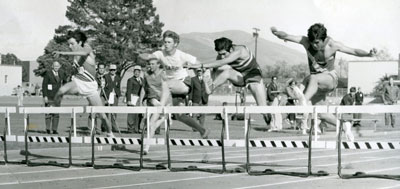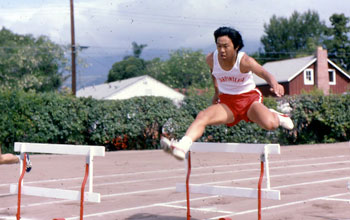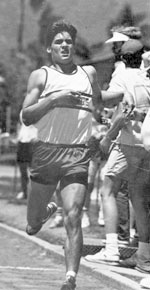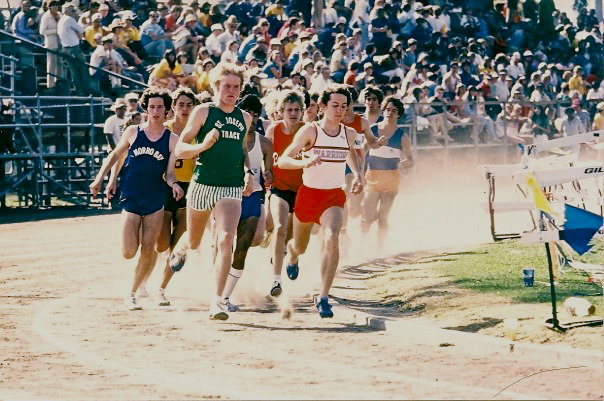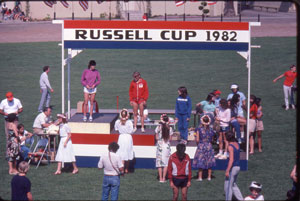It is surprising how many great ideas come about from just plain old everyday dinner conversation. In 1913, Carpinteria principal, Mr. Francis Figg-Hoblyn and Dorman Pischel had just finished dinner. Like most men in the area, they were engaged in a discussion of athletics in Carpinteria. Mr. Figg-Hoblyn wanted something more than the annual picnic and foot races that were held at the end of each school year. Something a little bigger, yet still involving the whole community. Thus the concept of the Russell Cup was born. After careful consideration and planning, the first track meet was held in the spring of 1913. It consisted of both elementary and high schools from Carpinteria as well as schools from Ventura County. At the end of the day Briggs School in Ventura had carried off the honors.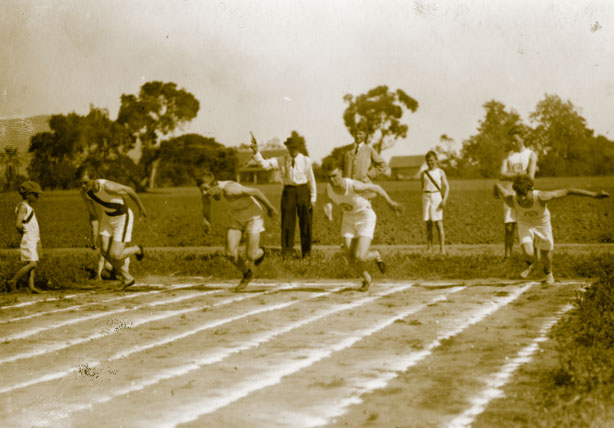
The track meet was such a success that it was decided that it would be held again in 1914. This time it was held on Memorial Day. Mr. & Mrs. Howland Shaw Russell, local athletic enthusiasts donated a silver cup to be given to the school that won the track meet three times. They did so hoping the track meet would become a tradition in Carpinteria. The track meet took on the name of the Russell Cup Track and Field Meet. Carpinteria invited three other schools to participate. The enthusiasm was much greater than the previous year. When the points were tallied at the end of the day, it was determined that Carpinteria had won the First Annual Russell Cup Track and Field Meet. (The 1913 meet wasn’t officially called the Russell Cup and isn’t counted in the annual tally of meet occurrences.) The meet was held each year after that and in 1917 Carpinteria won the meet again. The 1918 meet featured 15 schools and 150 athletes.
Since the meet was just starting out, sweaters were awarded instead of medals to the first, second, third and fourth place finishers in each event. The high school and grammar school points were combined during the early years of the Russell Cup. In 1920 the high schools and grammar schools were broken into separate divisions. The Russell Cup was awarded to the winner of the high school division and the Carpinteria Cup was awarded to the winner of the grammar school division. Among the events held were the 50-yard dash, shot put, pole vault, broad jump and the 880 yard relay.
1920’s ~ First Olympians
In 1920, Carpinteria won the meet for the third time and became the first permanent possessor of the Russell Cup. It was then retired and Kate Russell donated another cup. With the coming of the 20’s, the meet continued to grow in popularity. The 1924 meet featured 200 participants. The 12th annual meet of 1925 was enlarged in order to handle the large number of contestants and to offer a wider variety of events. Hurdle races were added to the meet for the first time in 1926. A new quarter-mile track was built in 1929 for the Russell Cup at the high school (now Carpinteria Middle School). Events were also reduced in 1929 to meet CIF requirements and new events replaced some of the old ones. By 1935 the meet was divided into two divisions. One for high schools over 1000 students and the other for high schools under 1000 students.
 The Russell Cup has always had the good fortune to host numerous outstanding athletes. One of the early greats was Clarence “Bud” Houser of Oxnard. He set the Russell Cup shot put record with a heave of 56' 3" in 1922. His Russell Cup record lasted almost 40 years. After the Russell Cup, Houser went on to further glory, winning the gold medal in the shot put at the 1924 Olympic Games in Paris. Houser was a double gold medalist in the discus as well. He took the crown at the 1924 games and the 1928 games in Amsterdam, setting Olympic records both times.
The Russell Cup has always had the good fortune to host numerous outstanding athletes. One of the early greats was Clarence “Bud” Houser of Oxnard. He set the Russell Cup shot put record with a heave of 56' 3" in 1922. His Russell Cup record lasted almost 40 years. After the Russell Cup, Houser went on to further glory, winning the gold medal in the shot put at the 1924 Olympic Games in Paris. Houser was a double gold medalist in the discus as well. He took the crown at the 1924 games and the 1928 games in Amsterdam, setting Olympic records both times.
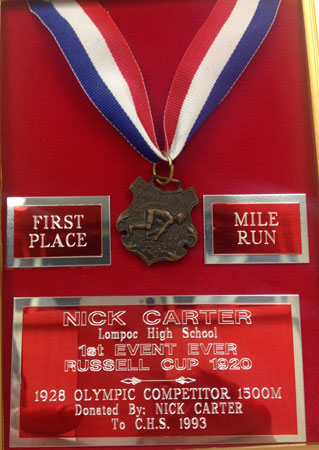 Nick Carter of Lompoc was the first Russell Cup athlete to become an Olympian. The winner of the Russell Cup mile in 1920, Carter ran the 1500 meters in 1928 games in Amsterdam. Carter turned to coaching after his running career and was the coach at UCSB for 33 years. In 1984 Carter donated a trophy bearing his name for the winner of the Russell Cup 1600 meters. He presented the trophy each year until his passing in 1997.
Nick Carter of Lompoc was the first Russell Cup athlete to become an Olympian. The winner of the Russell Cup mile in 1920, Carter ran the 1500 meters in 1928 games in Amsterdam. Carter turned to coaching after his running career and was the coach at UCSB for 33 years. In 1984 Carter donated a trophy bearing his name for the winner of the Russell Cup 1600 meters. He presented the trophy each year until his passing in 1997.
The first of many California State Champions to compete in the Russell Cup were a pair of jumpers from Santa Paula. Millard Webster won the inaugural state high jump title in 1915 with leap of 5’ 9 ½”. He also won the Russell Cup title that year as well. Teammate Lincoln Hall was the first state pole vault champ. He vaulted 11’ 6” in 1915 and back up his title with 11’ 9” victory in the 1916 state meet.
The Russell Cup began awarding gold medals to the high point winners in the 1922 and ribbons to the first, second, third and fourth place finishers in each event. Sweaters were awarded again in 1930 in an effort to save money. The homemaking department supplied the sweaters. Sponsorship by the American Legion post in 1934 allowed for the return of medals and trophies. The medals were round with the words “Russell Cup Meet, Carpinteria” inscribed around the picture of Carpinteria High School. The same design continues to this day.
As the meet continued to grow in the 20’s, larger schools such as Santa Barbara and Oxnard were rapidly out-classing the smaller schools. It soon became evident that Santa Barbara and Oxnard were the top teams at the meet. 1929 launched an era of domination for Santa Barbara as the Dons scored 51 ½ points to Oxnard’s 41 ½. Cate School was a distant third with 15 points.
Cate finished third due to the efforts of speedster Graham Hollister. He won the 100 yard dash in 9.8 seconds and the 220 yard dash in 21.2 seconds. The winning time in the 1928 Olympic 200 meter dash was 21.8 seconds. Hollister capped off his afternoon with a 20’ 11 ¾" long jump.
Needless to say, Hollister’s record 220 time created quite a buzz. As a matter of fact, his Russell Cup record has never been surpassed. However, he is no longer the record holder because of a technicality. In 1949, 20 years after he ran the race, a 5 foot drop from the start to the finish of the track’s 220 yard straightaway was discovered. The track was rebuilt and Hollister’s record dropped.
1930’s ~ A Decade of Growth
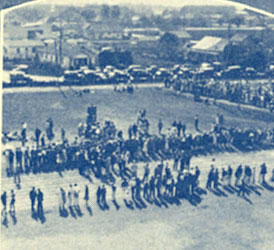 Santa Barbara won the Russell Cup again in 1932. During preparations for the 1933 meet, coach Clarence Schutte was quoted in the Santa Barbara Daily News, “The interest shown in this meet from year to year is indicative of a healthy attitude toward athletic activity other than football.” The Dons indeed proved to be healthy by doubling second place Oxnard’s point total to win the ’33 meet. The Dons retired the second Russell Cup by winning their third meet in the span of five years.
Santa Barbara won the Russell Cup again in 1932. During preparations for the 1933 meet, coach Clarence Schutte was quoted in the Santa Barbara Daily News, “The interest shown in this meet from year to year is indicative of a healthy attitude toward athletic activity other than football.” The Dons indeed proved to be healthy by doubling second place Oxnard’s point total to win the ’33 meet. The Dons retired the second Russell Cup by winning their third meet in the span of five years.
1933 was the 20th anniversary of the Russell Cup. It was also the year Clarence Schutte organized the Santa Barbara Easter Relays. The Olympics were held in Los Angeles the year before and interest in track and field ran high.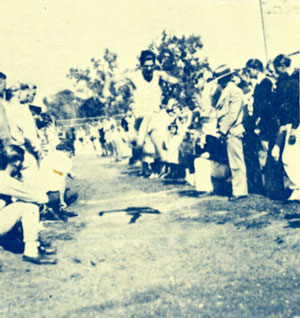
Kinter Hamilton, the assistant starter at the Olympics would handle the Russell Cup starting chores. The Carpinteria Chronicle reported, “It will be of great advantage to the competing athletes to have a man of Mr. Hamilton’s ability starting them.”
Kate Russell donated a new cup for the 1934 meet. There were 400 entrants from 15 schools and Santa Barbara won the meet again. The most exciting race of the day was an exhibition 100 yard dash by the “World’s Fastest Human”, Frank Wykoff. The two time Olympic gold medalist in the 4 x 100 relay and the world record holder in the 100-yard dash was a teacher at Carpinteria Union Elementary School (Main School). He turned in a time of 9.7 seconds that day. Wykoff would win his third Olympic 4 x 100 relay medal in the 1936 Berlin Olympics. The Los Angeles Times reported 1000 spectators at the ’34 meet while the Chronicle reported a figure of 2000 fans along with 800 hot dogs being sold.
The 25th renewal of the Russell Cup in 1938 saw the first of many perpetual trophies awarded. Frank Wykoff, now principal of Main School, donated the Frank Wykoff Trophy for the fastest 100-yard dash each year. Eddie Morris of Huntington Beach and Stanley Skafte of Compton tied for first place and were recipients of the first trophy. Just a sophomore, Morris went on to win 3 state championships at 220 yards and one 100 yard title. The 1930’s saw 13 state champions compete in the Russell Cup, the most for any decade of the Russell Cup.
A film of the 1939 Russell Cup was found in Fran Castro's garage. The film may be viewed here. 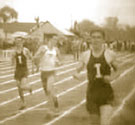
1940’s ~ The War Years
Bud Houser and Francis Figg-Hoblyn were guests of honor at the 1940 Russell Cup. Thelno Knowles of Santa Monica won the 880 yard race in a record time of 1:56.1 in 1941. This was the second fastest time in state history. In a decade scarred by World War II, the Russell Cup saw its first cancellation. The Russell Cup, like most athletic events of the time, went on hiatus from 1942 to 1946. The meet resumed on a limited basis in 1947 and 1948 but was canceled once again in 1949. The second cancellation occurred under better circumstances, though. The antiquated track and field was being rebuilt.
1950’s ~ Memorial Field
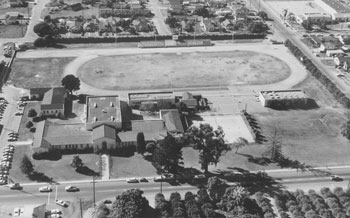 The Carpinteria High School student body and the school board raised enough money to renovate and rebuild the old track and field. The 5 foot drop in the straightaway was rectified and Memorial Field was born. Dedicated to Carpinterians who lost their life serving their country, Memorial Field would be the heart of athletic activity in Carpinteria for 50 years. In addition to hosting the Russell Cup for 40 years, Memorial Field hosted the CIF quarterfinals in 1951, ’53, ’54, ’58 and ’61 and the semi-finals in 1952 and ’54. The dirt track at Memorial Field had the reputation as being one of the fastest in Southern California.
The Carpinteria High School student body and the school board raised enough money to renovate and rebuild the old track and field. The 5 foot drop in the straightaway was rectified and Memorial Field was born. Dedicated to Carpinterians who lost their life serving their country, Memorial Field would be the heart of athletic activity in Carpinteria for 50 years. In addition to hosting the Russell Cup for 40 years, Memorial Field hosted the CIF quarterfinals in 1951, ’53, ’54, ’58 and ’61 and the semi-finals in 1952 and ’54. The dirt track at Memorial Field had the reputation as being one of the fastest in Southern California.
The 1950 meet was the first meet with “official” records. It was also the first year of the Mel Patton and Lions Club trophies. Mel Patton, 200 meter gold medalist at the London Olympics in 1948, donated one of his track shoes to be guilded and awarded to the most outstanding athlete, regardless of class or event. The Lions Club Trophy was awarded to the Carpinteria athlete scoring the most points at the meet.
The 1950’s saw a return to glory for the Russell Cup caused by post war prosperity and the newly dedicated Memorial Field. The 1953 meet brought back the big school, small school format. Many of the races were divided into races for schools under or over an enrollment of 1000 students. Field events were not broken into the large school, small school format however.
The Russell Cup witnessed its third future Olympian in 1952. Mike Larrabee of Ventura won the 100 and 440 yard dashes at the ’52 meet. He would go on to win two gold medals at the 1964 Olympics in Tokyo. Larrabee won individual honors in the 400 meters and was a member of the gold medalist 4x400 meter relay team. Ventura High School honored the former 400 meter world record holder by naming the school’s stadium after him.
The late 1950’s saw 3 state champions compete in the Russell Cup. Bob Avant of Hart won the Russell Cup and state high jump championship in 1957. Oxnard’s Ray Nickleberry followed Avant to win the ’58 state high jump title. The following year he set the Russell Cup record of 6’ 7”, a record that would last 35 years. 1959 also saw Bob Looney of Santa Barbara win the pole vault at the Russell Cup and the state meet.
1960’s ~ First Girls Competition
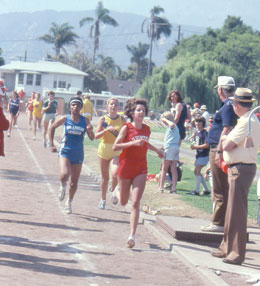 The Russell Cup was an all-male event until 1960. Though girls had been selected as Russell Cup princesses since 1938, no girl competed in the meet until 1960. The girls’ inclusion in the meet was limited to the 75 yard dash and the 440 relay, however. Fillmore won the first relay title in 1960. It wasn’t until 1973 that girls were competing in the
The Russell Cup was an all-male event until 1960. Though girls had been selected as Russell Cup princesses since 1938, no girl competed in the meet until 1960. The girls’ inclusion in the meet was limited to the 75 yard dash and the 440 relay, however. Fillmore won the first relay title in 1960. It wasn’t until 1973 that girls were competing in the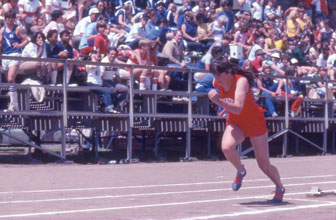 full complement of events. Dr. Fred Greenough, who was the meet’s director for many years and a well-known educator in Santa Barbara County, commented that during the 1930’s, “we…attempted to interest girl athletes in competing, but the woman P.E. instructors of those days felt this was not an appropriate activity for teen-age girls.”
full complement of events. Dr. Fred Greenough, who was the meet’s director for many years and a well-known educator in Santa Barbara County, commented that during the 1930’s, “we…attempted to interest girl athletes in competing, but the woman P.E. instructors of those days felt this was not an appropriate activity for teen-age girls.”
Carpinteria High School moved to its present location for the 1967-68 school year but the Russell Cup would continue at Memorial Field on the new Carpinteria Jr. High campus for another 20 years. 1968 did bring a major change in the Russell Cup’s format. The large schools were no longer part of the Russell Cup. The meet adopted the “small school” format that still holds true today.
Johnny Gilbert started the 60’s off on a fast pace. The Santa Barbara speedster won the 1960 and ‘61 100 yard dash titles in identical times of 9.9 seconds and the 220 yard dash in 1961. His time of 22.2 is still the Russell Cup record. The two mile was added to the Russell Cup in 1964. Shelton of Santa Barbara took home the first title. Fred De Bernardi of Hart broke the 60 foot barrier in the shot put for the first time in the 1967 Russell Cup. He established a new record of 60’ 7”.
1970’s ~ Frosh/Soph Division Created The 1971 Russell Cup was conducted under the lights of Memorial Field. This is the first and only time the meet was held at night. A cold and blustery evening made the conditions miserable for athletes and fans alike. Hometown hero Larry Stark was about the only one to find the conditions to his liking, as he broke the Russell Cup 100 yard dash record with a clocking of 9.7 seconds. The Russell Cup dropped the A, B, and C classification system in 1974 to align it with the new CIF system of varsity and frosh/soph competition. This has remained unchanged to this day in the boys divisions. The girls gained equal footing with the boys in 1994 when the frosh/soph division was created for the girls to complement the varsity division. Dave Laut broke the Russell Cup shot record in two ways in the 1970’s. The Santa Clara strongman established a new record with a 62' 5" heave in 1975. This record still stands strong today. 1975 also marked the third year in a row that Laut won the shot put title. No other boy can make that claim. Laut went on to win the bronze medal in the 1984 Los Angeles Olympics. The triple jump had brief engagements in the Russell Cup during the 1930’s and the 1960’s. It wasn’t until 1976 that the event was here to stay. Trypucka of Maranatha has owned the boys record for 20 years with his 45’ 10 ½” jump in 1984. The long jump earns the honors for having the oldest boys and girls records on the Russell Cup books. Jack Laughner of Long Beach Wilson soared 22’ 5 ¾” in 1939. He also set the triple jump record of 44’ 11” that year as well. Michelle Kelley of Irvine established her 17’ 4 ¾” long jump record in 1978. The Carpinteria boys were the team to beat during the beginning of the 1970’s. The host Warriors won four straight Russell Cups between 1970 and 1973. The San Marcos and Nordhoff girls tied for the most titles during the decade. San Marcos won the three straight cups from 1972 to 1974 while Nordhoff did the same from 1975 to 1977. |
|
1980’s ~ Return to Carpinteria High School The 63rd renewal of the Russell Cup in 1982 attracted a national class field in the boys’ distance races. The meet featured the national leader in the 800 meters, Don Young of St. Joseph, future state champion Tom Grewe of Carpinteria and George Yuster of Brentwood. Young would win the 880 in a record time of 1:55.5 and Grewe set records in both the mile and two mile. He ran 4:18.5 in the mile and 9:21.3 in the two mile, a record which still stands today. Bishop Union High School made long but successful trips from the Owens Valley in the 1980’s. The Bronco boys won three consecutive Russell Cups from 1982 to 1984. Carpinteria earned three varsity boys titles from 1986 to 1990. The girls’ side of the slate mirrored the boys. Santa Ynez and Paso Robles each won three Russell Cups during the decade. The first female perpetual trophy was awarded in 1982. The Martin Koobation Girls 3200 Meter Trophy was named after longtime Carpinteria teacher and principal Martin Koobation, who retired the year before. Sarah Allaback of Carpinteria received the first trophy. The Russell Cup left Memorial Field after the 69th edition in 1988. The Russell Cup was once again conducted on the Carpinteria High School campus, albeit it was the “new” campus on Foothill Road. Even though the high school track didn’t have all the amenities of Memorial Field, the actual competition sites were vastly superior to the decaying Memorial Field oval. Carpinteria’s Coley Candaele has the distinction of being the only person to own Russell Cup records at both sites. In 1987 and 1988, he set frosh/soph Russell Cup records in the 880 and mile at Memorial Field. In 1989 and 1990, he broke the varsity records in both events at Carpinteria High. All four of his records are still intact, with his best performances being a 1:51.40, 800 meter race and a 4:15.57, 1600 meter race in 1990. Candaele went on to win the state 1600 meter championship in 1990 as well. |
|
1990’s ~ Great Battles for the Cup
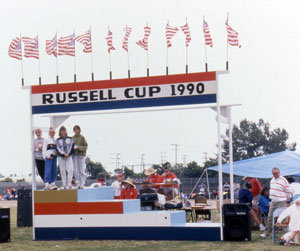 The team competition has been very balanced in both the girls and boys divisions since 1991. No school has won more than three titles in succeeding 15 year span. The triple win honors go to the Nordhoff boys and the St. Joseph girls. During this time, double winners have included the Carpinteria and St. Joseph boys and the girls’ teams from Carpinteria, Cate, Paso Robles and Piedmont.
The team competition has been very balanced in both the girls and boys divisions since 1991. No school has won more than three titles in succeeding 15 year span. The triple win honors go to the Nordhoff boys and the St. Joseph girls. During this time, double winners have included the Carpinteria and St. Joseph boys and the girls’ teams from Carpinteria, Cate, Paso Robles and Piedmont.
The jumping events were the property of Tracye Lawyer during the mid-1990’s. The Cate School athlete won four straight high jump titles and three long jump titles from 1992 to 1995. She was also state high jump champion in 1993. Lawyer demonstrated her versatility by winning the 100 meter hurdles in 1994 as well. Her all-around athletic ability paid dividends after high school. Lawyer won the NCAA heptathlon while representing Stanford in 1999.
1999 was a watershed year for the Russell Cup in more ways than one. The Russell Cup was in the same predicament it faced 50 years earlier, the meet was temporarily without a home because of construction of a new facility on the high school campus. Unlike 1949, the 1999 meet was not canceled. It was moved to La Playa Stadium on the campus of Santa Barbara City College. The 80th Russell Cup was the first meet held outside of Carpinteria and the first to be conducted on a synthetic track. Carpinteria’s John Barbieri is the only varsity athlete to set Russell Cup records on a non-Carpinteria track. He established records in the 110m high hurdles and the 300m intermediate hurdles in ’99.
2000 ~ Carpinteria Valley Memorial Stadium
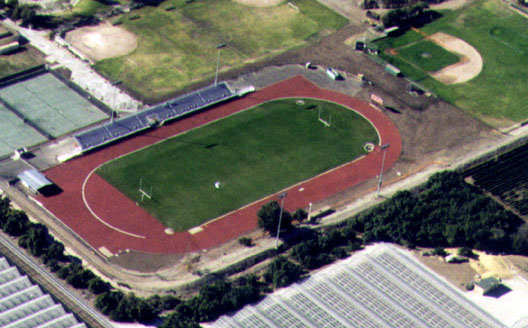 The new millennium opened a new era for the Russell Cup reminiscent of the era brought on by the opening of Memorial Field in 1950. The completion of Carpinteria Valley Memorial Stadium in 2000 provided a first class meet with a first class facility once again. This combination has only improved the reputation and the participation in the Russell Cup. The 2005 edition set new records with over 1000 athletes representing 41 schools. This entry total was surpassed in 2009 when 1580 athletes from 48 schools participated in the 90th edition of the Russell Cup.
The new millennium opened a new era for the Russell Cup reminiscent of the era brought on by the opening of Memorial Field in 1950. The completion of Carpinteria Valley Memorial Stadium in 2000 provided a first class meet with a first class facility once again. This combination has only improved the reputation and the participation in the Russell Cup. The 2005 edition set new records with over 1000 athletes representing 41 schools. This entry total was surpassed in 2009 when 1580 athletes from 48 schools participated in the 90th edition of the Russell Cup.
The new track was christened by future Olympian Allyson Felix of L.A. Baptist. The freshman set stadium records in both the 100 and 200 meter dashes while competing in the frosh/soph division. She earned the first Gibby Martin Award for the outstanding female athlete of the meet. Felix went on to be the silver medalist in the 200 meters at the 2004 Olympics in Athens and the 2008 Games in Beijing. She also won the gold in the 4x400 Relay in Bejing. Felix earned 3 gold medals in the 2012 London Olympic Games. She won the 200 meters and was on both the 4x100 and 4x400 relays teams. The 4x100 team broke the world record in addition to winning gold.
Another outstanding athlete to compete in the 2000 Russell Cup was Carpinteria's Chris Gocong, who set the Russell Cup discus record with a heave of 173' 4". Gocong excelled in football as well, earning the Buck Buchanan award in 2005 for the national defensive player of the year while at Cal Poly SLO. He has continued his career as a NFL linebacker for the Philadelphia Eagles and now the Cleveland Browns.
Shayla Balentine of Morro Bay has the unique distinction of holding a national record in a different event than her Russell Cup record. Balentine set the frosh/soph 100 meter dash record in 1999. She broke the national record in the pole vault with a 13' 8" clearance in the 2001 state meet. She never did win a Russell Cup pole vault. She finished fifth in 2000 and didn't compete in 2001.
Treani Swain of Oakwood celebrated the new millennium by winning 6 Russell Cup titles in the 400 and 800 meters. She began her run in 2000 with meet record in the 400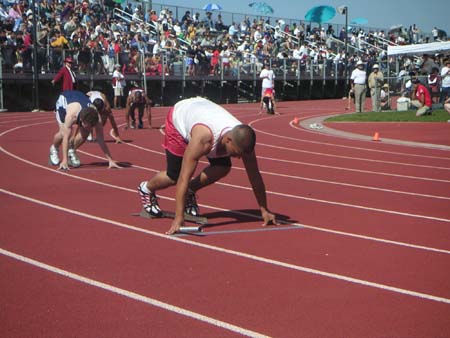 meters. She broke her own record two more times in '02 and '03. Her final record was 55.67 in the 400. Swain also won the 800 three straight years form 2001 to 2003.
meters. She broke her own record two more times in '02 and '03. Her final record was 55.67 in the 400. Swain also won the 800 three straight years form 2001 to 2003.
Sasha Blanchard of La Reina won 5 individual and 2 relay Russell Cup titles during 2005 through 2007 seasons. Her honor role includes two victories in the 100m hurdles, three 300m hurdle titles and two golds as a member of the 4x400 relay. She also set a meet record of 45.92 seconds in the 300m hurdles in 2006.
The Los Angeles Times ran a story about three venerated sporting events in Southern California. The Russell Cup was one of the events featured in the 2006 article.
St. Joseph and Oak Park High Schools have found the new facility at Carpinteria much to their liking as they have dominated the 21st century. Oak Park has won 5 boys sweepstakes titles, 6 girls sweepstakes and 7 grand sweepstakes. St. Joseph has earned 9 sweepstakes titles, 4 for the boys and 5 for the girls and taken 5 grand sweepstakes titles in the century's first decade. Oaks Christian has found success in the 2010's, winning 3 boys sweepstakes, 2 girls sweepstakes and 2 grand sweepstakes.
Tayler Johnson of Oak Park established herself as one of the most dominate performers in Russell Cup history becoming the first person to set 5 varsity Russell Cup records. During the 2009 and 2010 seasons, she set two records in the 100m hurdles, 2 more in the long jump and tied the high jump record. Only Carpinteria's Coley Candaele set more Russell Cup records but his were split, 3 in varsity competition and 3 at the frsoh/soph level.
Oak Park's Connor and Aubree Stark are the only brother sister combination to hold Russell Cup records. Connor topped Johnny Quinn's 15' 4" clearance with a 15' 6" vault in 2011. Aubree set her 11' 3 ¾" record in 2005.
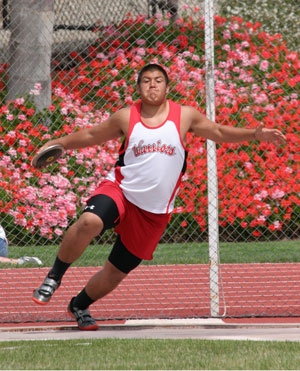 Ebony Crear has made a big impression in a short amount of time. The Maranatha sophomore has earned 8 frosh/soph titles in her first two years at the Russell Cup. She won the 100 meters, 100 hurdles, 300 hurdles and the 4x400 relay her freshman year. As a sophomore in 2012, she went 4 for 4 again. This time she broke 4 Russell Cup records in the process. Not only did she break the records in both hurdle races, she also broke Olympic champion Allyson Felix's records in the 100 and 200 meters. Unfortunately for Russell Cup fans she transfered from Maranatha after her sophomore year.
Ebony Crear has made a big impression in a short amount of time. The Maranatha sophomore has earned 8 frosh/soph titles in her first two years at the Russell Cup. She won the 100 meters, 100 hurdles, 300 hurdles and the 4x400 relay her freshman year. As a sophomore in 2012, she went 4 for 4 again. This time she broke 4 Russell Cup records in the process. Not only did she break the records in both hurdle races, she also broke Olympic champion Allyson Felix's records in the 100 and 200 meters. Unfortunately for Russell Cup fans she transfered from Maranatha after her sophomore year.
Courtney Corrin of Harvard-Westlake made her mark on the 2013 Russell Cup, the only time she competed in the meet setting Russell Cup records in both the long jump (19' 0") and triple jump (38' 1/2"). She went on to win the state championship in the long jump in 2013 and again in 2015.
The 2016 edition of the Russell Cup saw Branden Smith of Paraclete break the second oldest record in the Russell Cup annals. His 10.83 second run int he 100 meters eclipsed Carpinteria's Larry Stark mark from 1971. Branden also set the record in the 200 meters with a clocking of 21.76 seconds.
Daniel Burquez made Carpinteria history in 2017 becoming the first Warrior to win both the long jump and triple jump.
As the Russell Cup approaches its 99th edition on April 14, 2018, the meet continues to be a showcase for high school athletics. It is a fine example of competitive excellence, sportsmanship and youthful enthusiasm. The Carpinteria community has embraced the meet over the years. Over 100 volunteers show up year in and year out to conduct a very efficient and smooth event. The Russell Cup can be characterized by the qualities of excellence and tradition. The oldest high school meet in the state continues set the standard for high school track & field.
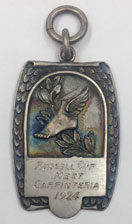 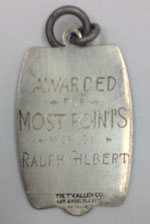 |
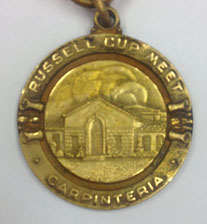 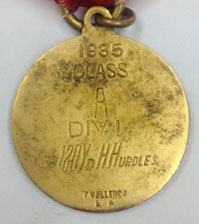 |
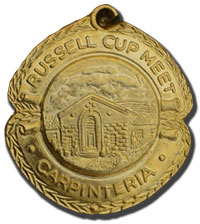 |
| 1924 Russell Cup Medal | 1935 Russell Cup Medal | Current Russell Cup Medal |
